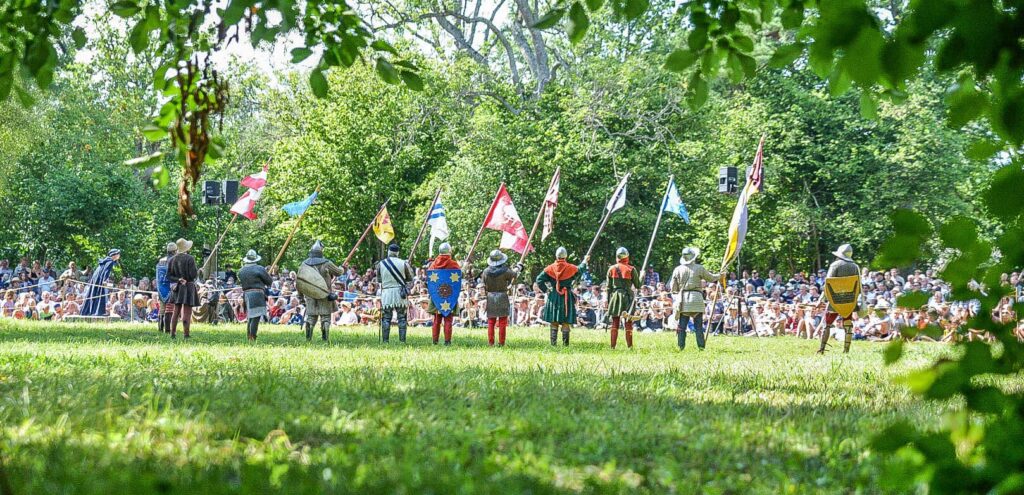
Each BoW year the battle of Mästerby is recreated on the island of Gotland. We wish to recreate the battle to illustrate how it might have played out at Mästerby in 1361. Reenactments is an excellent way to bring a historical event to life and, as a result, gain more understanding and knowledge.
The next battle will take place Thursday the 7th of August 2025.
Historical background
Sources discussing the Battle of Mästerby, 1361
Several sources from approximately the same time discuss three battles on the island of Gotland 1361. Amongst these sources are:
– Sjællandske Krønike, cirka 1365
– Libellus de Magno Erici Rege, written sometime between 1365 and 1371
These sources do not mention the location of these battles, except the one outside of the city of Visby. The first source to specifically name Mästerby is:
– Cronica Guthilandorum, by H.N. Strelow, 1633
Strelow’s account is written long after the events of 1361, but it is possible that he had access to older sources, which were destroyed in a fire at a vicarage, 1735. Strelow tells us that there were two battles at Fjäle Myr in Mästerby, over the course of two days, and that the Danish king had a stone cross raised at the Gren farm. It is not very likely, however, that Valdemar IV himself had the cross raised – a more likely scenario is that the Gotlanders did it themselves, a few years later.
Other things which indicate there were battles at Mästerby are, aside from the sources, tales and oral traditions, various findings. Among these are:
– Two rondel daggers
– Crossbow bolts
– Stirrups
– Spurs
– Lance heads
– Parts of maces
– Battle knives
– Parts of armor, such as lamellas, buckles and fittings
– Bits of chain mail
Many finds have been made, particularly during recent years, as archaeological expeditions have investigated the area.
All in all, sources, tales, findings and oral traditions provide us with unambiguous proof that there were battles between the Danish and the Gotlanders of Mästerby parish, only days before the battle outside the city wall of Visby.
Sources:
Mästerby 1361, Slagfältsarkeologi i Valdemar Atterdags fotspår
Link to the archaeological investigation at Mästerby (Swedish only):
http://www.masterby1361.se
Reenactment of the Battle of Mästerby
For the reenactment, the Gotlandic force is located on the northern side of the Suderting stream. A number of men are destroying the bridge across the stream. They are working fast, since their scouts have told them that the Danish army is close, and on its way. The Danes come in large numbers, with modern armour and modern weapons. The Gotlanders themselves have old equipment, but they are truly motivated. They fight to protect their families and their homes from the devastation brought by the Danish army.
The bridge finally crumbles, pulled down by horses, and it does so with a terrible crash. In the nick of time, because the Danish vanguard is in sight. The Danes spy out the Gotlanders and, after a while, they pick up formation and advance toward the stream. Getting into and then up from the stream furrow proves difficult; the Gotlanders hold their formations, stabbing and slashing anyone who tries to cross the stream. The Danish vanguard is forced to retreat several times, and at last, king Valdemar realises that his troops will not be able to cross. He sends scouts to find another passage over the stream. One is found nearby, at Fjäle myr. A group of Danish soldiers are sent to cross at Fjäle. The Gotlander crossbowmen and archers attempt to stop them, but their bolts are almost useless due to the modern, Danish armour. At the same time, the main Danish force attacks again, across the stream.
Suddenly, the Gotlanders find themselves battling their enemy at several fronts at once. Their lines break and parts of the Gotlander army starts to retreat. The Danish finally manage to cross the bog on horseback, and launch a full-scale attack. The Gotlanders are pursued and killed in a strenuous and merciless battle.